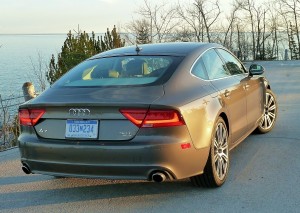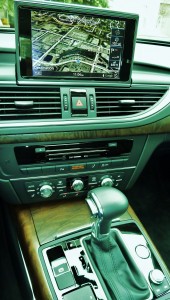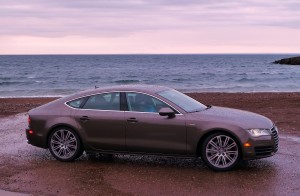A7 raises Audi standards for style, tech
By John Gilbert
Audi is unquestionably at the top rung of automotive styling as well as technology, and now Audi would like to stand out in U.S. sales, in a manner that might better reflect the popularity the brand enjoys throughout the rest of the world. If that’s an aggressive posture, Audi is deploying a new star player — the dramatically styled A7.
The “four-door coupe” look has been tried by many automakers, but it is a departure for Audi, and at first blush it would appear to be highly successful in execution. And Audi officials are not about to apologize for the departure. Brand Manager Scott Keough said, “The A7 is a boldly designed car, which deserves a boldly designed world,” then he pointed to a new ad campaign, which alerts all: “Let this be a warning to eyesores everywhere.”
Once a distant pursuer of German rivals from Mercedes and BMW, Audi has generally taken the conservative styling route, coupled with advanced technology, as it has evolved to a stronger competitive position in recent years. The look of Audi’s entire fleet sets the company apart, and distinctive styling is an Audi trademark, from its most compact A3 and on through the A4 and A6 to the luxury A8, as well as setting apart its Q7 and Q5 SUVs, and its sports cars, which range from the TT runabouts to the near-exotic R8 mid-engine classic.
The A7, however, sets a new plateau for Audi. It might be the most beautifully designed sedan ever built by Audi, with an aggressive nose that, we’re told, borrows heavily from the upcoming redesigned A6, which will ride on the same platform. But from the side, the A7 has a sweeping, coupe-like slope to the silhouette that tapers down in near-sports car fashion. At $59,250, it is priced just about the same as an A6, but well below the all-aluminum A8 flagship.
When the car was introduced, at the New York Auto Show in April, it looked very good sitting there on a pedestal, appearing to be similar in size to the midsize A6 but with a far more sporty flair. Recently, I’ve had the opportunity to drive and live with an A7 for a week, and it leaves no doubt that as good as it looks, the A7 performs with the hottest cars Audi has turned out.
For over a decade, Audi produced some exceptional small but overachieving engines for its smaller sedans and sporty cars, and whenever the company wanted to make a hot performer, such as the S4, S6 or others, it dabbled in turbocharging but primarily just stuffed the 4.2 liter V8 from the big A8 into smaller platforms with rousing performance results. The A7 represents a different approach, because lurking under that sleek hood is a 3.0-liter V6, bolstered by supercharging to develop 310 horsepower with 325 foot-pounds of torque. That’s easily enough to launch the quattro all-wheel-drive A7 in a truly sporting manner, and the 8-speed Tiptronic transmission guarantees it will continue in that sporty manner with instantaneous and smooth shifts, either up or down.
Audi has frequently used turbocharging to extract more power from, say, its 2.0-liter 4-cylinder, an engine that has widespread use throughout the Audi line and also powering parent Volkswagen’s GTI Golf, GLI Jetta, new Passat, CC sedan and Tiguan SUV. While a turbo takes exhaust flow and redirects it to run a turbine wheel that blows an increased fuel-air flow into the engine, a supercharger is run directly off an accessory drive and blasts air and fuel with direct suddenness into the engine.
The easiest explanation is to climb behind the wheel of any turbocharged Audi and, after being impressed with the building power at your command, then try the A7. Step on it hard, and you are instantly pressed against the seatback, as the car surges forward. You want to pass somebody? Hit the gas and you’ve leaped past.
To my surprise, while I only had a week to appreciate the blasts of power, which made it too tempting to pass up, it was also so efficient that we topped 30 miles per gallon in strictly freeway driving, and 27 or so was easily done overall.
The 3.0 supercharged V6 makes the A7 feel like a smaller and agile sport sedan, responding to throttle and steering inputs and benefitting from a sophisticated suspension system and, of course, Audi’s legendary quattro all-wheel drive system. The A6, according to Audi president Johan de Nysschen, is already outselling the Mercedes E-Class and BMW 5-Series sedans in Europe and Asia. The A6 fits nicely in the midsize segment and the A8 does the same in the luxury class, “and the A7 will appeal to buyers in both segments,” de Nyusschen said.
One of the challenges in the U.S. is that the A4 has been a solid leader for Audi, while its more luxurious upscale nameplates have been flourishing elsewhere. “We want to shift owners upmarket from their A4s,” de Nysschen added, “and while we pride ourselves on the drivetrain, the thing about the A7 that gets everybody is the emotional content of the car. It’s the kind of car that causes people to stop and look. It stands out from the crowd, but fits perfectly in our portfolio.”
In the midsize “C” segment, the A7 brings many of the high-end features from the A8, and it begs to have its technical sophistication described as much as its styling and performance. The styling is set off by what chief designer Ulrich Beierlein described as “two elegant lines, one sweeping up to the roof, and the other to the rear decklid.” The top line angles up near the “C” pillar, at the back of the cabin, to amplify the sloping roof in what is a new angular look for Audi.
“It was like thinking with your pencil, on a clean sheet of paper,” said Beierlein. “I was thinking of a gran turismo coupe, and the two horizontal lines accelerate from front to rear. It creates the elegant look of a coupe, and then uyou realize it’s a four-door coupe.”
The idea of the two crease lines continues inside, where the dashboard has two sweeping lines that angle the instruments to the driver. Mercedes started the idea of a four-door coupe with the previous generation CLS. Since then, Volkswagen successfully tried it with the CC sedan, and Jaguar, Acura and BMW have made stylish attempts to follow that lead. Interesting that as the A7 design was being readied for production, Mercedes renovated the CLS, and the new car is an impressive luxury car, but its side contours and overall silhouette abandon the four-door-coupe look that its predecessor made so striking.
If Audi inherits the leading-edge of that look, the A7 also sets new standards for electronic connectivity. The emotional impact Audi officials talk about is a combination of various technical features and real-world pampering. The fine leather and classy wood interior has an aura of quality and sportiness, sort of like settling into some friend’s high-buck sofa in his just-completed den. Only you’re in charge of this one. A screen rises to display navigation, maps, all sorts of information, and a heads-up display superimposed on the windshield just below your line of vision provides easy access to speed, fuel and other necessary information.
The MMI system offers touchpad controls, and the navigation is arranged through a partnership with Google Earth, with Wikipedia, weather, travel, and fuel prices all provided, as well as news headlines. In partnership with T-Mobile, the A7 becomes a rolling WiFi hotspot as well. Ford jumped ahead of everybody with its connectivity with Microsoft, Sony and others for its “Sync” system, but the competitors caught on quickly and are working their own arrangements.
For driver assistance, an infrared camera is used to create a night vision ability to see pedestrians ahead on a dark roadway, and Ultrasonic front sensors help the driver’s awareness of driveway obstacles and parking space room.
Some of the tech stuff fits well with what has become an Audi design trademark, such as the LED underline for the headlights, which are popular as daytime running lights, and the A7 goes a step further, bringing over the full-LED headlights of the A8.
The solid feel of the luxury A8 also permeates the A7 driving experience. Back in 1994, Audi revised the A8 into an all-aluminum masterpiece, with its aluminum body, platform, engine, suspension parts, and V8 engine, it was built like a jet aircraft, hundreds of pounds lighter than the same car would have been in steel, even with the added weight of quattro. The A7 uses a lot of high-strength aluminum, blended with steel, and when you slam the door, you definitely get the feeling of solidity.
With the torque fluctuating among all four wheels via quattro, the car starts out feeling more securely planted. A suspension system that combines a five-link front with trapezoidal-link rear, and designed to separate the shock absorbers from the suspension, make it feel even more stable, but never harsh while it holds its flat attitude in cornering. Electromechanical power steering is precise, and offers more feel than most electric power-steering units. It also saves 35 pounds of weight compared to a normal mechanical steering setup.
The A7 seems perfectly timed as well as well positioned to bolster Audi’s popularity. Audi vehicles ranked as seventh on the list of cross-shopped luxury sedans in 2006, and now they are No. 2 in the luxury segment. In recent months, Audi has increased sales at the rate that has doubled its market share.
All part of the plan, said brand manager Keough. “Audis have always seemed to be quiet, intellectual, and somewhat unknown,” he said. “If we want to be the best, we must also become ‘known.’Â People purchase luxury items to get something better than the normal, and the same holds true for luxury cars.”
Audis always have set standards that are a little bit different from the norm, and the new A7 could be a lightning rod to carry that concept to new heights.
Comments
One Comment on A7 raises Audi standards for style, tech
-
reasons to move to hawaii on
Tue, 15th Jul 2014 12:20 am
I am truly thankful to the owner of this website who has shared this
great paragraph at this place.
(Exactly which paragraph so impressed you> — JG)
Tell me what you're thinking...
and oh, if you want a pic to show with your comment, go get a gravatar!






 John Gilbert is a lifetime Minnesotan and career journalist, specializing in cars and sports during and since spending 30 years at the Minneapolis Tribune, now the Star Tribune. More recently, he has continued translating the high-tech world of autos and sharing his passionate insights as a freelance writer/photographer/broadcaster. A member of the prestigious North American Car and Truck of the Year jury since 1993. John can be heard Monday-Friday from 9-11am on 610 KDAL(www.kdal610.com) on the "John Gilbert Show," and writes a column in the Duluth Reader.
John Gilbert is a lifetime Minnesotan and career journalist, specializing in cars and sports during and since spending 30 years at the Minneapolis Tribune, now the Star Tribune. More recently, he has continued translating the high-tech world of autos and sharing his passionate insights as a freelance writer/photographer/broadcaster. A member of the prestigious North American Car and Truck of the Year jury since 1993. John can be heard Monday-Friday from 9-11am on 610 KDAL(www.kdal610.com) on the "John Gilbert Show," and writes a column in the Duluth Reader.